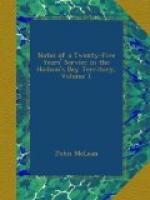In their intercourse with us the Nascopies evince a very different disposition from the other branches of the Cree family, being selfish and inhospitable in the extreme; exacting rigid payment for the smallest portion of food. Yet I do not know that we have any right to blame a practice in them, which they have undoubtedly learned from us. What do they obtain from us without payment? Nothing:—not a shot of powder,—not a ball,—not a flint. But whatever may be said of their conduct towards the whites, no people can exercise the laws of hospitality with greater generosity, or show less selfishness, towards each other, than the Nascopies. The only part of an animal the huntsman retains for himself is the head; every other part is given up for the common benefit. Fish, flesh, and fowl are distributed in the same liberal and impartial manner; and he who contributes most seems as contented with his share, however small it may be, as if he had had no share in procuring it. In fact, a community of goods seems almost established among them; the few articles they purchase from us shift from hand to hand, and seldom remain more than two or three days in the hands of the original purchaser.
The Nascopies, surrounded by kindred tribes, are strangers to the calamities of war, and are consequently a peaceful, harmless people; yet they cherish the unprovoked enmity of their race towards the poor Esquimaux, whom they never fail to attack, when an opportunity offers of doing so with impunity. Our presence, however, has had the effect of establishing a more friendly intercourse between them; and to the fact that many of the Esquimaux have of late acquired fire-arms, and are not to be attacked without some risk, may be ascribed, in no small degree, the present forbearance of their enemies.
CHAPTER X.
THE ESQUIMAUX—PROBABLE
ORIGIN—IDENTITY OF LANGUAGE
FROM LABRADOR TO BEHRING’S
STRAITS—THEIR
AMOURS—MARRIAGES—RELIGION—TREATMENT
OF PARENTS—ANECDOTE—MODE
OF PRESERVING
MEAT—AMUSEMENTS—DRESS—THE
IGLOE, OR SNOW-HOUSE—THEIR
CUISINE—DOGS—THE
SLEDGE—CAIAK, OR CANOE—OUIMIAK,
OR
BOAT—IMPLEMENTS—STATURE.
The Esquimaux are so totally different in physiognomy and person, in language, manners, and customs, from all the other natives of America, that there can be no doubt that they belong to a different branch of the human race. The conformation of their features, their stature, form, and complexion, approximate so closely to those of the northern inhabitants of Europe, as to indicate, with some degree of certainty, their identity of origin. In the accounts I have read of the maritime Laplanders, I find many characteristics common to both tribes: the Laplander is of a swarthy complexion,—so is the Esquimaux; the Laplander is distinguished by high cheek-bones, hollow cheeks, pointed chin, and large mouth,—so




